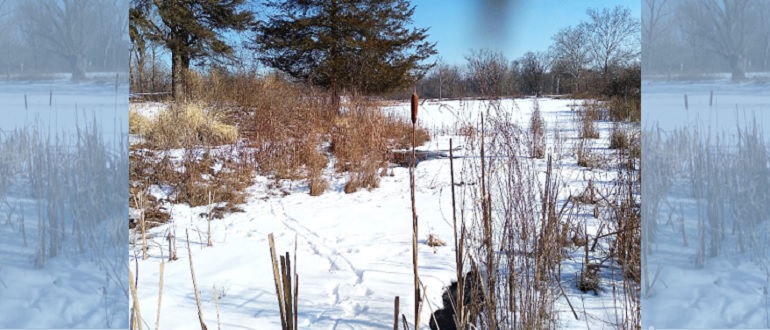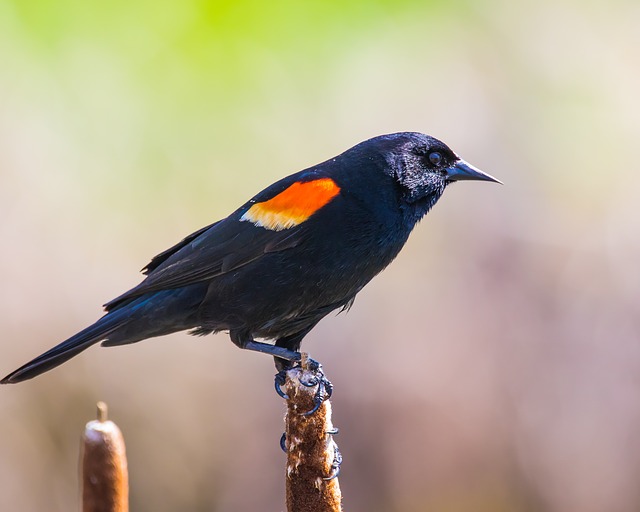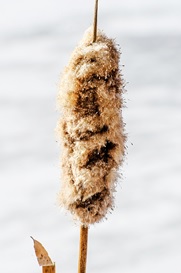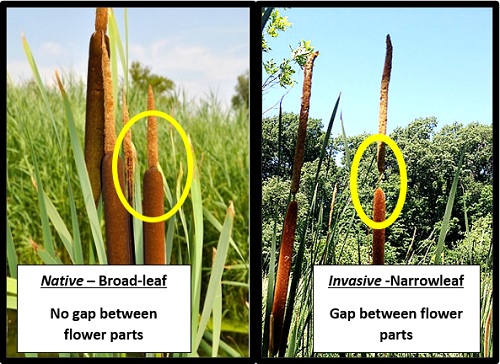GET TO KNOW –
Cattails
Along the edge of a frozen pond, dried stalks of cattails decorate the winter landscape. Rising up through ice and snow, cattails are stalwarts of their wetland community. Rooted under the frigid water, these intriguing plants offer food and shelter to a multitude of wetland creatures and are often called “the plant with a thousand uses.”
FUN FACT – According to Victorian tradition, in the “language of flowers,” cattails are a symbol of peace and prosperity. Consequently, the presentation of a cattail stalk as a gift served as an offering of peace in hopes of ending a conflict.
Throughout the year, cattails provide underwater cover for fish, frogs and turtles. Geese, beavers and muskrats dine on young, tender cattail shoots while muskrats use cattail stalks for their lodge building. Many marsh birds use cattail seed fluff for nest insulation, and the sturdy stalks of cattail colonies serve as the primary nesting grounds of the red-wing blackbird. Cattail seeds are generally too tiny for birds to eat, but several moths (and other insects) use cattails as larval hosts.
Historically, cattails were prized by native peoples the world over. They have been widely used for food, medicine and building materials. Pretty much all parts of the plant are edible – including the rhizomes – and can be cooked as vegetables or made into tonics. (Unfortunately, due to cattail’s ability to absorb heavy metal toxins, plants harvested in our modern world may not be safe for consumption.) Native communities also used cattails for weaving and building. Leaves were woven or sewn into durable baskets and waterproof mats while seed fluff served as an insulating filler.
Yet, in spite of its many ecosystem uses and beneficial gifts, cattails are controversial within the field of wetland restoration/management. On the one hand, a stand of cattails serves as an excellent biofilter to help reduce excess nitrogen, phosphorous, heavy metals, suspended solids and salts in the surrounding water and soil. Likewise, cattails can slow the flow of rapid storm water run-off and reduce erosion. However, wetland managers are often reluctant to use cattails in managed projects. The main reasons for this reluctance are:
- Cattail colonies can spread aggressively and potentially crowd-out other desired species.
- Dense stands of cattails may block engineered waterflow patterns around spillways, drain systems, etc.
- Natural growth (and decay) cycles of large cattail colonies can lead to a build-up of bottom sludge, long-term reduction in oxygen levels and eutrophication (aging) of the wetland system. (Excess plant cover over the water’s surface reduces oxygen levels, and decaying plants return previously absorbed toxins back into the water/soil. True removal of toxins requires the harvesting and safe disposal of filter plants.)
- An invasive version (narrow-leaf cattail Typha angustifolia) of cattail has become widespread and has hybridized with the native species (broad-leaf cattail Typha latifolia).
Consequently, cattail populations often need to be heavily controlled in order to meet the goals of specific restoration projects.
On a separate note, the industrial world has taken note of cattail’s many merits. Researchers are currently experimenting with formulations of “typhaboard” (based on cattail’s scientific name of Typha) as an eco-friendly, load-bearing/insulating, building material. Additionally, the army has used cattail fluff for insulation purposes, and other research groups are experimenting with cattail as a source of biofuel. Perhaps cattail may, once again, be recognized as the plant with a thousand uses.
PLANT SPECIFICATIONS
Cattail is an emergent, aquatic plant. It usually grows as a dense colony that is rooted in the saturated soil of a wetland or shallow pond. Leaves and flower stalks can grow up to 10 ft in height and reach high above the waterline. The native Typha latifolia (broad-leaf) survives only in shallow water (up to 2ft) and can tolerate some periods of drying out. However, the invasive Typha angustifolia (narrow-leaf) cattail can survive and spread through deeper water.
A cattail reproduces through the spread of underground rhizomes and by seed dispersal. Within an existing colony, spreading rhizomes generate new shoots to expand the colony. In the fall, cattail pods release hundreds of thousands of tiny, fluffy, airborne seeds that drift away to start new colonies.
It can be difficult to distinguish between the native, broad-leaf (Typha latifolia) and the invasive, narrow-leaf (Typha angustifolia) cattail – especially if the hybrid species is also present. Though the names imply a nice, visual distinction in leaf size, the difference is actually quite small. Broad-leaf cattail leaves average just under one inch wide while the invasive plant’s leaves average slightly over ½ inch wide. The easiest way to tell the two species apart is by the arrangement of the flower stalks in summer.
The plant’s distinctive pods are actually its flowers. Each new flower stalk has two separate sections. The narrow tip is a clump of tiny male flowers that sits above the wider, brown pod of female flowers. (Note, the male flowers wither and drop-off once seeds are formed.)
On stalks of native broad-leaf cattail, the male section of the flower clump rests directly on the female flower pod. On stalks of the invasive narrow-leaf plant, there is a visible gap on the stalk between the male and female flowers. Of course, as the naturally occurring hybrid species continues to spread, these minor differences may simply disappear – hopefully without harm to the beavers, muskrats, birds, and moths.
TAKE ACTION
Natural wetlands are one of the world’s most valuable treasures. Preserving the health of our rivers – even those in urban watersheds – helps protect our remaining wetlands.
To learn more about the value of wetlands, sign up to survey Rouge wetlands for frogs and toads and get to know cattails, wetlands and maybe even meet a tiny frog on a cattail.
Categories
-
News & EventsLearn more about upcoming FOTR events and projects



